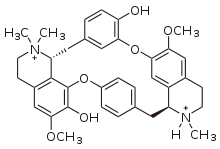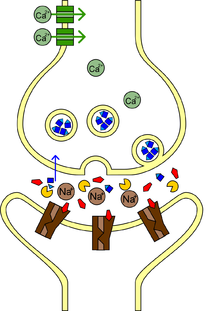Tubocurarine
- Tubocurarine
-
| Tubocurarine |
 |
| Général |
| Nom IUPAC |
7',12'-dihydroxy-6,6'-diméthoxy-2,2',2'-triméthyltubocuraranium |
| No CAS |
6989-98-6 |
| Code ATC |
AA02, AA04 |
| PubChem |
6000 |
| SMILES |
Oc7ccc1cc7Oc5cc6[ C@ H]( Cc4ccc( Oc2c3[ C@@ H]( C1)[ N+]( C)( C) CCc3cc( OC) c2O) cc4)[ NH+]( C) CCc6cc5OC
PubChem, Vue 3D
|
| InChI |
InChI : Vue 3D
InChI= 1/ C37H40N2O6/ c1- 38- 14- 12- 24- 19- 32( 42- 4) 33- 21- 27( 24) 28( 38) 16- 22- 6- 9- 26( 10- 7- 22) 44- 37- 35- 25( 20- 34( 43- 5) 36( 37) 41) 13- 15- 39( 2, 3) 29( 35) 17- 23- 8- 11- 30( 40) 31( 18- 23) 45- 33/ h6- 11, 18- 21, 28- 29H, 12- 17H2, 1- 5H3,( H-, 40, 41)/ p+ 2/ t28-, 29+/ m0/ s1
|
| Propriétés chimiques |
| Formule brute |
C37H40N2O62+ [Isomères]
|
| Masse molaire[1] |
608,7233 ± 0,0346 g·mol-1
C 73 %, H 6,62 %, N 4,6 %, O 15,77 %,
|
| Classe thérapeutique |
| Curare non-dépolarisant |
| Données pharmacocinétiques |
| Biodisponibilité |
100 % |
| Demi-vie d’élim. |
1 à 2 heures |
| Considérations thérapeutiques |
| Voie d’administration |
Intraveineuse |
|
Unités du SI & CNTP, sauf indication contraire.
|
La tubocurarine est un curare non-dépolarisant naturel de la famille des benzylisoquinolines, antagoniste spécifique des récepteurs nicotiniques. Elle est obtenue à partir de Chondodendron tomentosum. Autrefois utilisée comme myorelaxant en anesthésie générale, elle est aujourd'hui tombée en désuétude au profit des curares synthétiques en raison de sa toxicité et de son potentiel allergisant. Elle reste toutefois utilisée aux États-Unis pour certaines exécutions capitales par injection.
Notes et références
Wikimedia Foundation.
2010.
Contenu soumis à la licence CC-BY-SA. Source : Article Tubocurarine de Wikipédia en français (auteurs)
Regardez d'autres dictionnaires:
tubocurarine — [tybokyʀaʀin] n. f. ÉTYM. Mil. XXe; de tubo (du lat. tubus « tube »), curare, et suff. ine. ❖ ♦ Méd. Alcaloïde extrait d une plante sud américaine et obtenu aussi par synthèse, à action curarisante, employé en anesthésie, dans certains états… … Encyclopédie Universelle
Tubocurarine — drugbox IUPAC name = width2 = 150 CAS number = 57 94 3 ATC prefix = M03 ATC suffix = AA02 ATC supplemental = ATC|M03|AA04 PubChem = 6000 DrugBank = APRD00176 ChemSpiderID = 5778 C=37 | H=41 | N=2 | O=6 molecular weight = 609.731 g/mol… … Wikipedia
Tubocurarine chloride — Systematic (IUPAC) name 6,6 dimethoxy 2,2 … Wikipedia
tubocurarine — noun Etymology: International Scientific Vocabulary tubo (from Latin tubus tube) + curare + ine; from its being shipped in sections of hollow bamboo Date: 1898 a toxic alkaloid or its crystalline hydrochloride salt C37H42Cl2N2O6 that is obtained… … New Collegiate Dictionary
tubocurarine — An alkaloid that acts as a muscle relaxant by blocking acetylcholine (ACh) receptors … Dictionary of molecular biology
tubocurarine — /tooh boh kyoo rahr een, in, tyooh /, n. Pharm. the principal active alkaloid of curare, C38H44Cl2N2O, used as a muscle relaxant, esp. as an adjunct to anesthesia. [1895 1900; < G Tubocurarin, equiv. to Tubocurar(e) (see TUBE, O , CURARE) + in… … Universalium
tubocurarine — noun A benzylisoquinoline alkaloid, obtained from curare and sometimes used to paralyse patients undergoing anaesthesia … Wiktionary
tubocurarine — tu·bo·cu·ra·rine .t(y)ü bō kyu̇ rär ən, .ēn n a toxic alkaloid that is obtained chiefly from the bark and stems of a So. American vine (Chondrodendron tomentosum of the family Menispermaceae), that in its dextrorotatory form constitutes the chief … Medical dictionary
tubocurarine — tu·bo·cu·ra·rine … English syllables
tubocurarine — tu•bo•cu•ra•rine [[t]ˌtu boʊ kyʊˈrɑr in, ɪn, ˌtyu [/t]] n. pha the principal active alkaloid of curare, C38H44Cl2N2O, used as a muscle relaxant, esp. as an adjunct to anesthesia • Etymology: 1895–1900; < G Tubocurarin=Tubocurar(e) (see tube, o … From formal English to slang

 Mode d'action de la tubocurarine (en rouge) au niveau de la plaque motrice. Le curare se fixe au récepteur nicotinique (marron), empêchant l'action de l'acétylcholine (en bleu) qui est dégradée par l'acétylcholinestérase (en jaune).
Mode d'action de la tubocurarine (en rouge) au niveau de la plaque motrice. Le curare se fixe au récepteur nicotinique (marron), empêchant l'action de l'acétylcholine (en bleu) qui est dégradée par l'acétylcholinestérase (en jaune).
